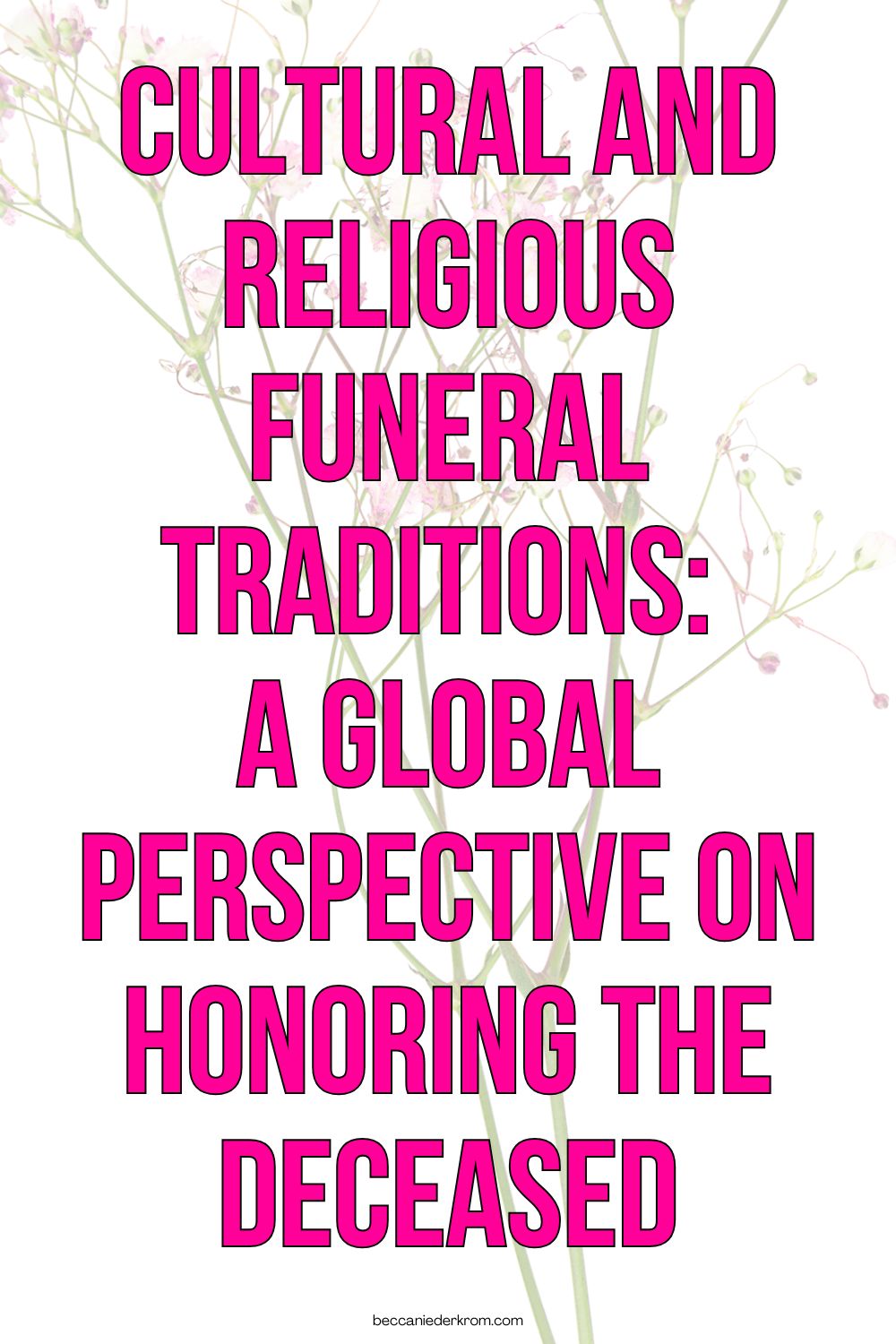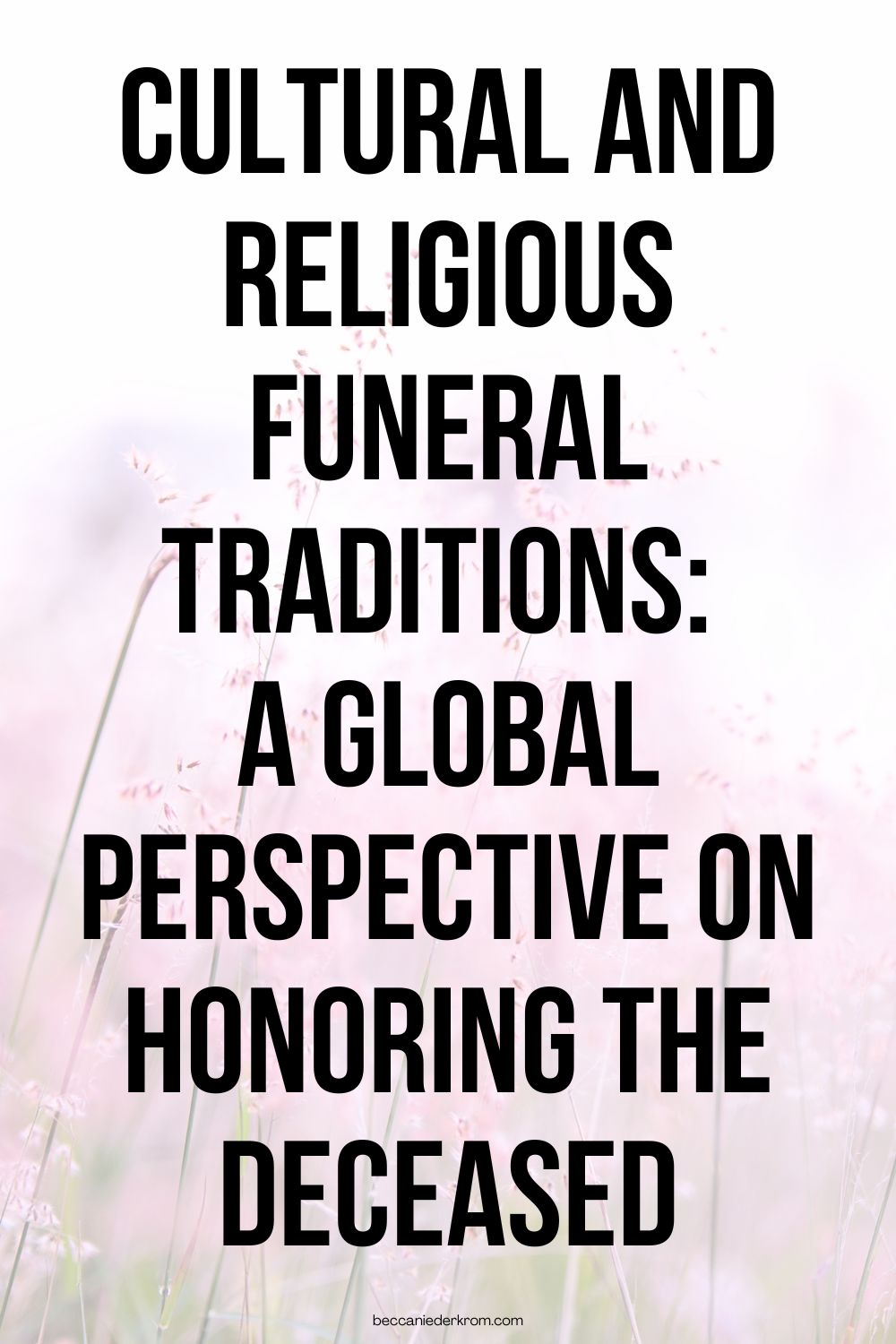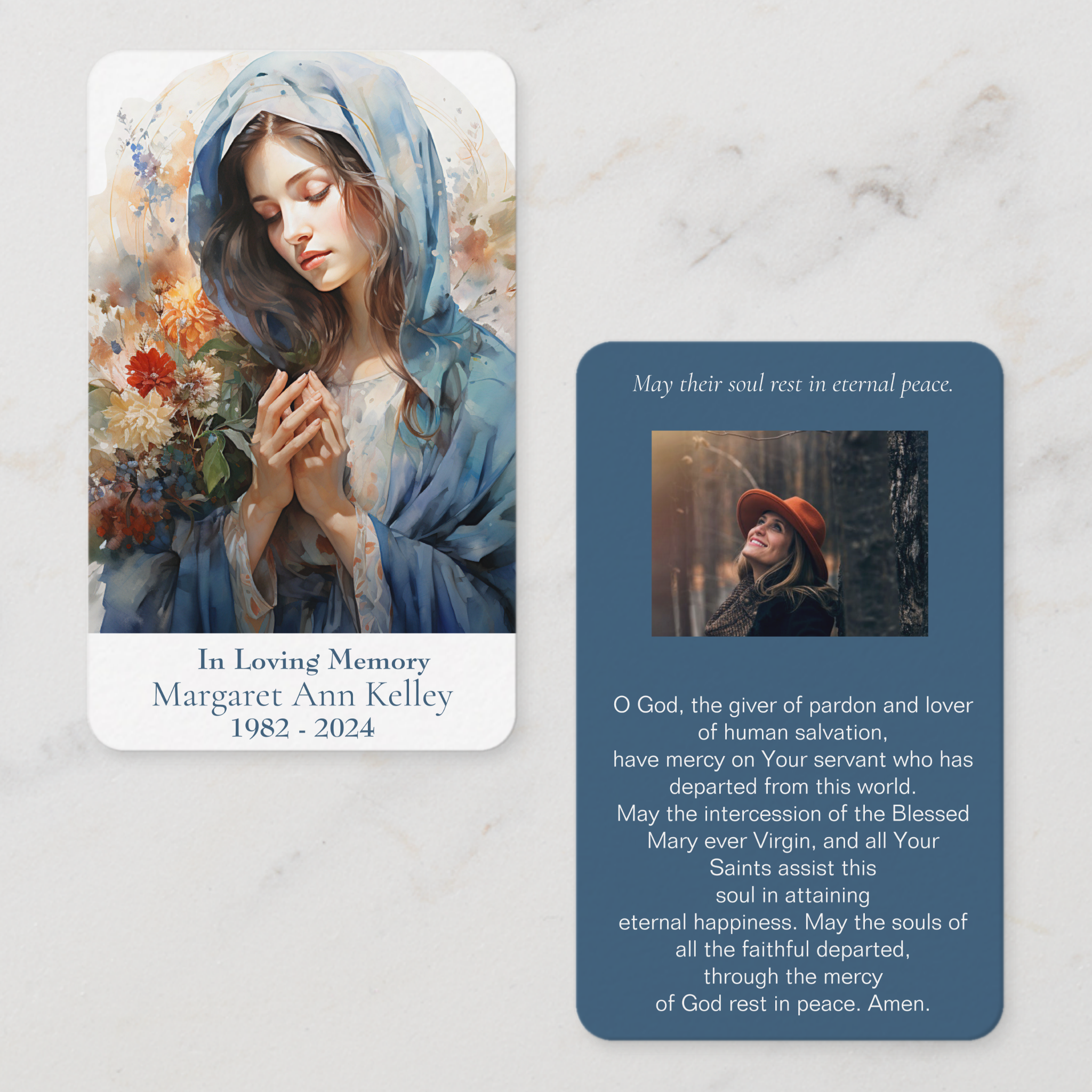We may earn money or products from the companies mentioned in this post. As an Amazon Associate I earn from qualifying purchases. Disclosure of Material Connection: Some of the links in this post may be "affiliate links." This means if you click on the link and purchase an item, I will receive an affiliate commission.
Throughout human history, the ways in which we honor and remember our deceased loved ones have been deeply intertwined with cultural heritage, religious beliefs, and societal values. Funeral traditions across the globe offer fascinating insights into how different communities understand death, process grief, and maintain connections with ancestors. This comprehensive exploration of cultural and religious funeral traditions provides a global perspective on the diverse ways humanity pays tribute to those who have passed.
Cultural and Religious Funeral Traditions: A Global Perspective on Honoring the Deceased
The Universal Language of Grief and Remembrance
Despite the remarkable diversity in funeral practices worldwide, certain elements remain consistent across cultures. The need to honor the deceased, provide comfort to the bereaved, and create meaningful transition rituals appears universal. These commonalities remind us that while our practices may differ, our fundamental human experience with loss connects us across cultural boundaries.
Anthropologists suggest that funeral rituals serve several essential functions: they help the living accept the reality of death, provide structured ways to express grief, offer community support, and facilitate the transition of the deceased to whatever comes next according to cultural beliefs. Understanding these shared purposes helps us appreciate both the similarities and differences in global funeral traditions.
Eastern Traditions: Honoring Ancestors and Facilitating Spiritual Journeys
Japanese Buddhist Funeral Traditions
In Japan, where Buddhism has profoundly influenced funeral practices, rituals focus on helping the deceased transition to the next life. Traditional Japanese funerals (告別式, sōgi) typically include:
- Wake ceremonies (tsuya) where family members stay with the deceased overnight
- Purification rituals with incense and water
- Kaimyō naming, where the deceased receives a special Buddhist name for the afterlife
- Cremation followed by a bone-picking ceremony (kotsuage) where family members transfer cremated remains to an urn using special chopsticks
- Memorial services (nenki) held at specific intervals after death for up to 33 years
The annual Obon Festival represents another significant Japanese tradition, during which families welcome back the spirits of ancestors for a brief reunion. Lanterns are lit to guide spirits home, traditional dances are performed, and food offerings are made at household altars and graves.
SNAG THE FREE FUNERAL PLANNER CHECKLIST HERE
Chinese Ancestral Veneration
Chinese funeral traditions blend elements of Confucianism, Taoism, and Buddhism, with practices varying by region and family background. Common elements include:
- Wearing white mourning clothes rather than black, as white symbolizes purity and the natural cycle of life
- Burning joss paper (sometimes called “ghost money”) and paper replicas of material goods to provide for the deceased in the afterlife
- Professional mourners who may be hired to demonstrate the family’s filial piety
- Feng shui considerations for burial sites to ensure good fortune for descendants
- Elaborate processions with musicians and symbolic objects
The Qingming Festival (Tomb Sweeping Day) occurs annually in April, when families visit ancestral graves to clean the sites, make offerings, and pay respects. This tradition, dating back over 2,500 years, reinforces the continuing bonds between the living and deceased family members.
Hindu Death Rituals and Cremation
Hindu funeral traditions emphasize the soul’s journey after death and the importance of proper rituals to ensure a successful transition. Key elements include:
- Preparation of the body by family members, including washing with purified water and dressing in simple white clothes
- Open-air cremation traditionally performed by the eldest son, who circles the pyre and breaks the deceased’s skull to release the soul
- Immersion of ashes in sacred rivers, particularly the Ganges
- Shraddha ceremonies performed for ten days after death to nourish the departed soul
- Annual remembrance rituals on the death anniversary
The concept of reincarnation fundamentally shapes Hindu funeral practices, with proper rituals believed to help the soul (atman) break the cycle of rebirth (samsara) and achieve liberation (moksha).
Western and Abrahamic Traditions: From Ancient Practices to Modern Adaptations
Christian Funeral Traditions
Christianity encompasses numerous denominations with varying funeral practices, though certain elements remain common:
- Funeral Mass or service centered around prayers for the deceased’s soul
- Readings from scripture emphasizing resurrection and eternal life
- Burial traditions historically preferred over cremation, though many denominations now accept both
- Symbols of faith such as crosses, candles, and holy water
- Communal gathering after the service to support the bereaved family
Catholic traditions include specific elements like the Requiem Mass, prayers for the soul in purgatory, and the use of sacraments. Eastern Orthodox Christians maintain distinctive practices including the open casket, specific prayer services like the Trisagion, and memorial services held at prescribed intervals.
Protestant denominations generally emphasize simpler services focused on celebrating the deceased’s life and the promise of resurrection, with practices varying widely among different churches.
Jewish Burial Customs
Jewish funeral traditions emphasize simplicity, equality in death, and prompt burial:
- Chevra kadisha (burial society) members prepare the body according to ritual requirements
- Simple wooden caskets without metal components to allow natural decomposition
- Shemira practice of never leaving the deceased alone between death and burial
- Keriah ritual of tearing garments or wearing black ribbons to symbolize grief
- Shiva seven-day mourning period when family receives visitors at home
The principle of “k’vod ha-met” (honoring the deceased) guides Jewish funeral practices, with emphasis on treating the body with respect while acknowledging that the soul has departed. Annual remembrance through yahrzeit observances and the recitation of Kaddish (mourner’s prayer) maintains connections with the deceased.
SNAG THE FREE FUNERAL PLANNER CHECKLIST HERE
Islamic Janazah Practices
Islamic funeral traditions emphasize simplicity, promptness, and community participation:
- Ghusl ritual washing of the body performed by family members of the same gender
- Kafan simple white shroud used to wrap the deceased
- Salat al-Janazah funeral prayer performed by the community
- Burial directly in the ground without a casket when possible, with the face turned toward Mecca
- Prohibition of cremation based on religious teachings about bodily resurrection
The Islamic concept of Akhirah (afterlife) shapes funeral practices, with the belief that the deceased begins experiencing either comfort or torment immediately after burial. Mourning is permitted but expected to be restrained, with formal mourning periods limited to three days except for widows, who observe a waiting period of four months and ten days.
Indigenous and Traditional Practices: Maintaining Ancient Connections
Native American Tribal Traditions
Native American funeral practices vary significantly among the hundreds of distinct tribes, each with unique cultural traditions. Some common elements include:
- Preparation rituals often involving washing the body and dressing in special clothes
- Sacred objects placed with the deceased for use in the afterlife
- Ceremonial songs and dances to guide the spirit
- Varying disposal methods including burial, scaffold exposure, and cremation depending on tribal traditions
- Extended mourning periods with specific behavioral restrictions
Many tribes maintain the belief that improper funeral rituals can cause the deceased’s spirit to linger and potentially cause harm to the living. The Ghost Dance, practiced by various tribes in the late 19th century, represented a spiritual movement centered around communing with deceased ancestors and bringing about cultural renewal.
African Traditional Funeral Ceremonies
Across the African continent, funeral traditions reflect diverse cultural beliefs while often emphasizing the deceased’s transition to becoming an ancestor who remains connected to the community:
- Extended ceremonies lasting days or weeks, with different phases for various aspects of the transition
- Animal sacrifice in some traditions to honor the deceased and provide spiritual nourishment
- Elaborate coffins in certain regions, such as Ghana’s fantasy coffins shaped to represent the deceased’s profession or interests
- Community participation through singing, dancing, and storytelling to celebrate the deceased’s life
- Secondary burial practices where remains are exhumed and reburied with additional ceremonies after a prescribed period
In many African traditions, proper funeral rites are considered essential not only for the deceased’s journey but for the wellbeing of the entire community. Ancestors are believed to maintain active interest in their descendants’ lives, offering protection when properly honored.
Modern Innovations and Emerging Practices
Green Burial and Eco-Friendly Options
Environmental consciousness has influenced funeral practices globally, with growing interest in sustainable alternatives:
- Natural burial grounds that prohibit embalming, concrete vaults, and non-biodegradable materials
- Biodegradable caskets and shrouds made from materials like bamboo, willow, or unbleached cotton
- Conservation burial that combines human burial with land preservation
- Human composting (natural organic reduction) now legal in several U.S. states
- Memorial reef balls incorporating cremated remains into artificial reef structures
These practices often connect with ancient traditions that emphasized the body’s return to the earth, while addressing modern environmental concerns about conventional burial and cremation practices.
Digital Memorialization and Virtual Funerals
Technological advances have created new dimensions in funeral practices:
- Online memorial sites where friends and family can share memories and condolences
- QR codes on headstones linking to digital tributes
- Livestreamed funeral services allowing distant mourners to participate
- Virtual reality experiences recreating memorial spaces
- Digital legacy planning for social media accounts and online assets
As of late, there has been an accelerated the adoption of virtual funeral elements, demonstrating how technology can maintain community connections even when physical gathering is impossible. These innovations continue to evolve, creating new traditions that blend digital and physical elements.

Cross-Cultural Influences and Adaptation
In our increasingly interconnected world, funeral practices often reflect cultural blending and adaptation:
- Diaspora communities maintaining traditional practices while incorporating elements from their new homeland
- Interfaith families creating hybrid ceremonies honoring multiple religious traditions
- Secular adaptations of traditionally religious rituals to accommodate changing beliefs
- Personalization becoming increasingly important across cultures
- Legal and practical constraints shaping how traditional practices are modified in different countries
These adaptations demonstrate the dynamic nature of funeral traditions, which continue to evolve while maintaining connections to cultural heritage. Rather than diminishing cultural distinctiveness, these adaptations often represent thoughtful engagement with both tradition and contemporary circumstances.
Respecting Diversity While Finding Common Ground
Understanding diverse funeral traditions offers several benefits:
- Enhanced cultural competence for funeral professionals serving diverse communities
- Deeper appreciation of our own cultural practices and their meanings
- Improved ability to support grieving friends from different backgrounds
- Recognition of our shared humanity despite different expressions of grief
- Inspiration for meaningful personalization of contemporary funeral practices
As we navigate an increasingly multicultural society, knowledge of various funeral traditions helps us approach death and grief with greater sensitivity and respect. While practices differ dramatically, the underlying human needs for meaningful farewell rituals, community support, and continued connections with those we’ve lost remain universal.
SNAG THE FREE FUNERAL PLANNER CHECKLIST HERE
Conclusion: The Evolving Tapestry of Funeral Traditions
Cultural and religious funeral traditions represent one of humanity’s most profound expressions of values, beliefs, and community bonds. From the elaborate ancestor veneration practices of East Asia to the simple dignity of Islamic burial, from traditional African ceremonies to emerging eco-friendly alternatives, these diverse approaches to honoring the deceased reflect our collective wisdom about facing mortality.
As global citizens, we have unprecedented opportunities to learn from different cultural approaches to death and remembrance. This knowledge enriches our understanding of human experience and provides valuable perspectives for navigating our own encounters with loss. By approaching diverse funeral traditions with respect and openness, we discover not only fascinating cultural variations but also the common threads of our shared humanity.
Whether maintaining centuries-old practices or creating new traditions that reflect contemporary values, funeral rituals continue to serve their essential purpose: helping the living honor the dead, process grief, and maintain meaningful connections across the threshold of mortality.




